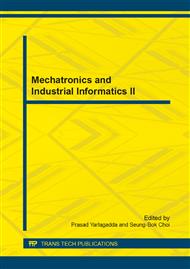[1]
I.F. Akyildiz, W. Su, Y. Sankarasubramaniam, E. Cayirci, Wireless sensor networks: a survey, Computer networks, Vol. 38 (2002) , pp.393-422.
DOI: 10.1016/s1389-1286(01)00302-4
Google Scholar
[2]
L.M. SUN et al.: Wireless Sensor Networks (Tsinghua University Press, Beijing 2005).
Google Scholar
[3]
H.B. YU, W. LIANG, P. ZENG: Intelligent wireless sensor networks (Science Press, Beijing 2013).
Google Scholar
[4]
H.M.F. AboElFotoh, S.S. Iyengar, K. Chakrabarty: Computing reliability and message delay for cooperative wireless distributed sensor networks subject to random failures. IEEE Trans Reliab, Vol. 54(2005), p.145–155.
DOI: 10.1109/tr.2004.842540
Google Scholar
[5]
D. Bein, V. Jolly, B. Kumar, S. Latifi: Reliability modeling in wireless sensor networks, International Journal of Information Technology, Vol. 11 (2005), pp.1-8.
Google Scholar
[6]
A. Shrestha, L. Xing: Quantifying application communication reliability of wireless sensor networks, International Journal of Performability Engineering, Vol. 4 (2008) , p.43.
Google Scholar
[7]
A. Shrestha, L. Xing, H. Liu : Modeling and evaluating the reliability of wireless sensor networks, Reliability and Maintainability Symposium, 2007. RAMS'07. Annual, IEEE, (2007), pp.186-191.
DOI: 10.1109/rams.2007.328105
Google Scholar
[8]
J. Duane: Learning curve approach to reliability monitoring , Aerospace, IEEE Transactions on, Vol. 2 (1964) , pp.563-566.
DOI: 10.1109/ta.1964.4319640
Google Scholar
[9]
L.H. Crow: Reliability analysis for complex, repairable systems , SIAM Reliability and Biomeiry, Philadelphia, (1974), pp.379-410.
Google Scholar
[10]
A.L. Goel, K. Okumoto: Time-dependent error-detection rate model for software reliability and other performance measures, Reliability, IEEE Transactions on, Vol. 28 (1979), pp.206-211.
DOI: 10.1109/tr.1979.5220566
Google Scholar
[11]
M. Xie: Software reliability modelling, World Scientific, (1991).
Google Scholar
[12]
M. Zhao: Change-point problems in software and hardware reliability, Communications in Statistics-Theory and Methods, Vol. 22 (1993), pp.757-768.
DOI: 10.1080/03610929308831053
Google Scholar
[13]
M. Zhao: Superposition of Power-Law Models for Hardware/Software System Reliability Data Analysis , International Journal of Reliability, Quality and Safety Engineering, Vol. 10 (2003) , pp.121-130.
DOI: 10.1142/s0218539303001044
Google Scholar
[14]
J.F. Yang,M. Zhao: Maximum likelihood estimation for software reliability with masked failure data, Journal of Systems Engineering and Electronics, Vol. 35, (2013), pp.2665-2669.
Google Scholar
[15]
S. Yamada: Software Reliability Modeling: Fundamentals and Applications (Springer Briefs in Statistics, Springer Japan, 2014).
Google Scholar
[16]
M. Zhao, M. Xie: EM algorithms for estimating software reliability based on masked data, Microelectronics Reliability, Vol. 34 (1994), pp.1027-1038.
DOI: 10.1016/0026-2714(94)90067-1
Google Scholar
[17]
L.H. Crow: Evaluating the reliability of repairable systems, Proceedings of Annual Reliability and Maintainability Symposium, IEEE, (1990), pp.275-279.
DOI: 10.1109/arms.1990.67969
Google Scholar
[18]
V.V. Krivtsov: Practical extensions to NHPP application in repairable system reliability analysis , Reliability Engineering & System Safety, Vol. 92 (2007), pp.560-562.
DOI: 10.1016/j.ress.2006.05.002
Google Scholar
[19]
H. Guo, A. Mettas, G. Sarakakis, P. Niu: Piecewise NHPP models with maximum likelihood estimation for repairable systems, Reliability and Maintainability Symposium (RAMS), 2010 Proceedings-Annual, IEEE, (2010), pp.1-7.
DOI: 10.1109/rams.2010.5448029
Google Scholar
[20]
M. Dias De Oliveira, E.A. Colosimo, G.L. Gilardoni: Power law selection model for repairable systems , Communications in Statistics-Theory and Methods, Vol. 42 (2013), pp.570-578.
DOI: 10.1080/03610926.2011.609954
Google Scholar
[21]
V.V. Krivtsov: Recent advances in theory and applications of stochastic point process models in reliability engineering, Reliability Engineering & System Safety, Vol. 92 (2007), pp.549-551.
DOI: 10.1016/j.ress.2006.05.001
Google Scholar
[22]
J. Van Dyck, T. Verdonck: Precision of power-law NHPP estimates for multiple systems with known failure rate scaling, Reliability Engineering & System Safety, Vol. 126 (2014), pp.143-152.
DOI: 10.1016/j.ress.2014.01.019
Google Scholar
[23]
B. Zhang, J.X. Zhang: Applied Stochastic Processes, (Tsinghua University Press, Beijing 2004).
Google Scholar
[24]
P. O'Connor, A. Kleyner: Practical reliability engineering, (Fifth Edition, John Wiley & Sons, 2012).
Google Scholar


